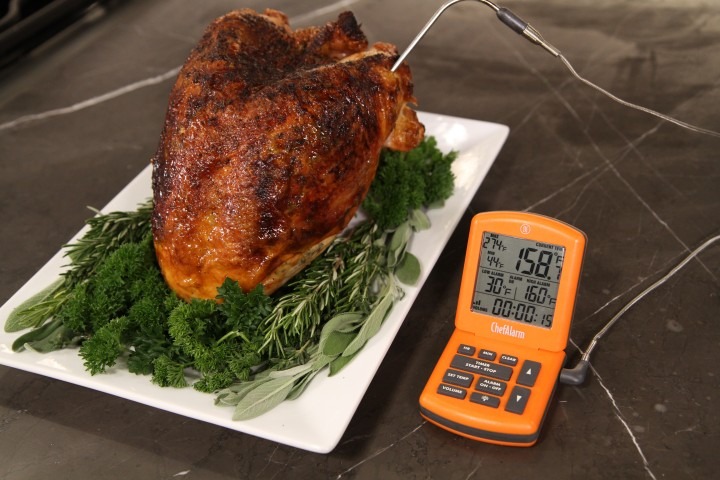For many home cooks, roasting a whole turkey can feel intimidating. The large size, longer cooking time, and fear of drying out the breast meat leads some to just skip making their own turkey. However, cooking a boneless turkey breast provides a simpler, foolproof path to juicy, flavorful holiday centerpieces. Follow these turkey breast cooking tips to achieve the ideal temperature and texture.
Picking the Right Turkey Breast
Turkey breasts come in a few forms:
-
Boneless – Fully deboned and rolled into a log shape. Easy to cook but less dramatic at the table.
-
Bone-in – Still has breastbone and some ribs attached. Takes a bit more skill but looks impressive.
-
Hotel-style – A bone-in breast with wings and other parts intact. Closest to a whole turkey experience
For beginners, a boneless 3-5 pound breast is a good choice. The challenge lies in keeping the lean breast meat moist. A bone-in or hotel-cut breast adds flavor but requires more planning.
Prepping Your Turkey Breast
Proper prep ensures even cooking
-
Thaw safely – Thaw turkey in the fridge 1 day per 4-5 pounds. Defrost in cold water if short on time.
-
Dry brine – Salt the breast 1-2 days before cooking for juicier meat.
-
Loosen skin – Separate skin from meat gently with fingers. Rubseasoned butter or oil underneath.
-
Truss or tie – For bone-in and hotel breasts, truss legstogether and tuck wing tips under.
Determining Cook Time and Temperature
Cooking time varies by size and type. General guidelines:
-
Boneless breast – Bake at 350°F for 20 minutes per pound.
-
Bone-in breast – Roast at 350°F for 18 minutes per pound.
-
Hotel-style breast – Roast at 350°F for 15 minutes per pound.
For food safety, turkey breasts should reach 165°F at the thickest part. Juicier results come from pulling it at 155-157°F and letting the temp rise as it rests.
Use a good digital meat thermometer to track the internal temp. Check in a few places to confirm even cooking.
Roasting Tips for Maximum Juiciness
To prevent dry turkey breast, focus on retaining moisture:
-
Cook at 350°F – Higher heat dries out poultry.
-
Use a roasting pan with a rack – Gets airflow under breast.
-
Add aromatics to the pan – Carrots, onions, herbs add flavor.
-
Baste with pan juices – Helps keep meat moist as it cooks.
-
Let rest before carving – Allows juices to redistribute.
Common Turkey Breast Roast Times
Here are estimated roasting durations:
-
3 pound boneless breast – 60-75 minutes
-
5 pound bone-in breast – 90-120 minutes
-
7 pound hotel-style breast – 105-140 minutes
Check temps early and extend time if needed for food safety. Rest at least 15 minutes before carving.
Is Your Turkey Breast Done? Foolproof Ways to Check
Visual signs hint your breast is cooked through:
-
Thermometer hits 165°F at thickest area
-
Meat is no longer pink at the bone
-
Juices run clear when pierced
-
Skin is golden brown
But investing in a good digital meat thermometer is the only sure way to confirm safety and prevent overcooking.
Step-by-Step Guide to Roasting Boneless Turkey Breast
Follow this simple process for foolproof results:
-
Thaw and dry brine turkey breast 1-2 days in advance.
-
Preheat oven to 350°F. Prepare rack and pan.
-
Pat breast dry. Coat with oil or butter and season.
-
Roast 20 minutes per pound, basting occasionally.
-
Check temperature, extending cook time if needed.
-
Let rest 15+ minutes before slicing and serving.
Common Mistakes to Avoid
Some key pitfalls lead to dried out or undercooked turkey:
-
Not thawing completely – Can cause unsafe, uneven cooking.
-
High roasting heat – Temps above 375°F overcook poultry.
-
No thermometer – Guessing doneness leads to safety risks.
-
Cutting before resting – Causes juices to run out onto the cutting board.
-
Roasting from frozen – Drastically prolongs cook time and yields poor texture.
Alternate Cooking Methods
Beyond roasting, you can also cook turkey breasts using:
-
Grill – Gets nice char. Needs frequent turning and basting.
-
Smoke – Adds flavor. Requires special equipment and more time.
-
Sous vide – Cooks gently in sealed bag immersed in water bath. Finishes with quick sear.
-
Fry – Super moist and crispy skin. Equipment is specialized and hot oil can be dangerous.
-
Braising – Great for tough hotel breasts. Cook in flavorful liquid on stovetop or in oven.
Serving Your Perfectly Cooked Turkey Breast
Once rested, slice your turkey across the grain for tenderest texture. Serve warm with classic Thanksgiving sides and sauces. Refrigerate leftovers within 2 hours. Sliced turkey keeps well frozen for 2-3 months. Enjoy scraped or shredded meat in casseroles, salads, sandwiches and more!
With the right technique, you can confidently cook turkey breast to ideal doneness. Follow these tips for juicy, crave-worthy results at your next holiday meal or Sunday supper.

What temperature does a cooked turkey breast need to be?
FAQ
Is turkey done at 165 or 180?
What temperature is a turkey breast done?
Does turkey breast have to be 165?
Is turkey breast OK at 160?
